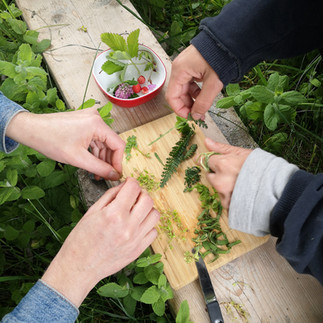Wild Herbs Workshop
- Himmelbeet

- Nov 25, 2022
- 3 min read
In this activity participants get to know some wild herbs of the surroundings through interactive methods. They share personal experiences, explore intercultural aspects of the herbs and invent a short story.
Goal of the exercise
Raising interest in wild herbs; getting to know the wild herbs in their natural environment; promoting creativity, sharing knowledge and exploring intercultural aspects (e.g. by sharing names of the herbs in other languages, traditional uses and stories).
Participants
Number of participants:
5 to 25 persons
Target group:
adults, young people, children, mixed groups, intercultural groups, teams.
Age of participants:
Aged 5 or above. No more than 20 children only.
Duration of the method
45 to 60 minutes, depending on the length of the initial information.
Materials / Location
Pictures of the wild herbs selected or of different parts (leaves, flowers, seeds), depending on the number of participants.
Printed list of questions for each small group (see attached document).
Pencils and clipboards for note-taking.
A green space (garden, park, forest). Make sure the site is not polluted, especially if participants are meant to taste or consume the herbs.
Preparation
Visit the site beforehand to identify which herbs could be used for this method (maximal 8 to 10 wild herbs) and ensure that it is not polluted.
Get information about the wild herbs to be used, take photographs, look for illustrations or collect parts of the herbs shortly before organising the activity.
Prepare questions for the search that are adapted to the target group’s characteristics (language, age, special needs, etc.). Graphic elements are likely to be useful. Or use the template provided (see attached template).
Reflect on how to accommodate possible special needs of participants.
Work out a time schedule for each part of the activity.
(Optional) Collect visual documents on the wild herbs that will be used and that can be exhibited on a board, showing the wild herbs during different stages of their life cycle or significant parts of them (leaves, seeds, flowers, etc.). Prepare labels for them.
Step by step
Ask participants to form a circle. Present yourself and briefly explain the method. If appropriate, use an icebreaker so that participants can get to know each other: ask participants in turn to announce their name and their favourite (wild or cultivated) plant if they have one.
Introduce the topic by taking into account participants’ previous knowledge of wild herbs. Ask participants why wild herbs are interesting. Common answers are: health and nutritional reasons, use for cooking or preparing cosmetics, traditional knowledge, self-sufficiency, interest in botany or biodiversity, a connection to nature.
Ask participants what we should know before gathering wild herbs (e.g. how to recognise them, how to taste or consume only safely identified herbs, cleaning plants before consuming them, avoiding polluted sites).
Divide participants into small groups of two to four persons and assign to each group the task of looking for a spot where a particular wild herb is growing on the chosen site and answering a number of questions. If appropriate, provide them with a photograph or a part of the wild herb they will be searching for or use a board with visual information (see Preparation). Hand out the list of questions you have prepared or the template provided. Count about 15 min for the task.
Gather participants in a circle and let each small group in turn share their findings. If appropriate, provide additional information about each wild herb, especially for participants who are new to the topic. The aim is to create common knowledge available to all. Conclude by asking participants for feedback about this method.
Alternative use
Add a cooking session to the workshop during which participants first collect more herbs, clean them and then prepare a dish or several to be enjoyed on the spot or taken away for later consumption. You could, for example, prepare a wild herb pesto and a salad and share them with some bread!
Feedback
Try to keep it simple! Some people have little botanical knowledge and might find it difficult to identify a wild herb or recognise it by name.
Adapt the activity to the target group (allocated time, previous knowledge, etc.).
Encourage participants to use all their senses to explore the wild herbs or use storytelling for an easier approach. Giving room to creativity means more fun and makes the method more inclusive for participants who don’t know much about wild herbs.
Facilitate knowledge transfer between participants.
Accommodate participants’ special needs (e.g. by exhibiting wild herbs on a table if participants experience mobility restrictions).
Experiences
“This activity was fun! We shared our stories about the plant we looked for, we had the possibility to be creative together by inventing a story.”
“I liked the fact that the plant plays an active role: it can talk and tell us something. It shows a way to turn around the human-centred perspective”.
“I felt inspired to go looking for wild herbs in my neighbourhood and getting to know them better, also for preparing home-made teas and meals.”








Comments